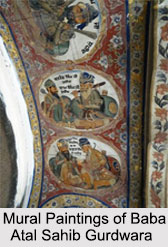 Gurdwara Baba Atal Sahib is a well-known Gurdwara of Amritsar. Millions of pilgrims visit the Gurdwara Baba Atal Sahib every year. It is one of the significant tourist spots of Amritsar. Originally a samadhi enshrining the remains of Atal Rai (1628), a son of Guru Hargobind, it was transformed into a Gurdwara.
Gurdwara Baba Atal Sahib is a well-known Gurdwara of Amritsar. Millions of pilgrims visit the Gurdwara Baba Atal Sahib every year. It is one of the significant tourist spots of Amritsar. Originally a samadhi enshrining the remains of Atal Rai (1628), a son of Guru Hargobind, it was transformed into a Gurdwara.
Location of Gurdwara Baba Atal Sahib
Gurdwara Baba Atal Sahib is situated to the south of the Golden Temple, about 185 metres from Sarai Guru Ram Das. It is situated in the City of Amritsar. It is located on the back side of Gurdwara Shri Harmindar Sahib.
Legends of Gurdwara Baba Atal Sahib
 According to legend Atal Rai, at the age of 9, restored his close friend Mohan, to life after his sudden demise. Guru Hargobind rebuked him on displaying one"s spiritual power. Atal Rai chose to take a samadhi for breaking the law. Although he died at the age of 9, he was honoured with the title of "Baba". The nine-storey of the Gurdwara represents the 9 years of his life.
According to legend Atal Rai, at the age of 9, restored his close friend Mohan, to life after his sudden demise. Guru Hargobind rebuked him on displaying one"s spiritual power. Atal Rai chose to take a samadhi for breaking the law. Although he died at the age of 9, he was honoured with the title of "Baba". The nine-storey of the Gurdwara represents the 9 years of his life.
Architecture of Gurdwara Baba Atal Sahib
Gurdwara Baba Atal Sahib is a nine-storey octagonal tower which stands 40 metres high and is the tallest building in Amritsar. There are four doors on the ground floor, one on each of the cardinal sides. The main entry faces towards east. Surrounded by the interior octagonal height, it is enshrined in a beautifully shaped brass canopy, surmounted by an exquisite chhatri. The doors are made of silver and brass. Brass plates marked with figures telling Sikh and Hindu themes are attached in a set of three plates on each of the four external doors.
The most representative specimens of the art of decoration on brass that thrived in Amritsar in the hands of craftsmen of "Kucha Fakirkhana". The interior walls of the first floor are adorned with murals. A huge series of paintings spread out, stage by stage, the life of Guru Nanak. Murals in a noticeably damaged state are also to be seen at the first entrance to the shrine. Large panels demonstrate scenes from the life of Baba Atal and Guru Nanak; and the different stages of the battle of Muketsar. A few damaged paintings are also to be seen on the front wall of "Tosha Khana", the treasury, to be found adjoining to the tower.
Visiting Information of Gurdwara Baba Atal Sahib
Raja Sansi International Airport is the nearest airport. Amritsar Railway Station is the nearest railway station. Regular bus services are also available to reach Gurdwara Baba Atal Sahib.





















